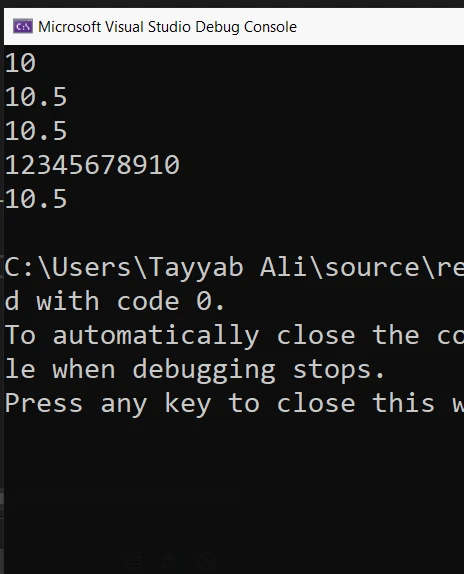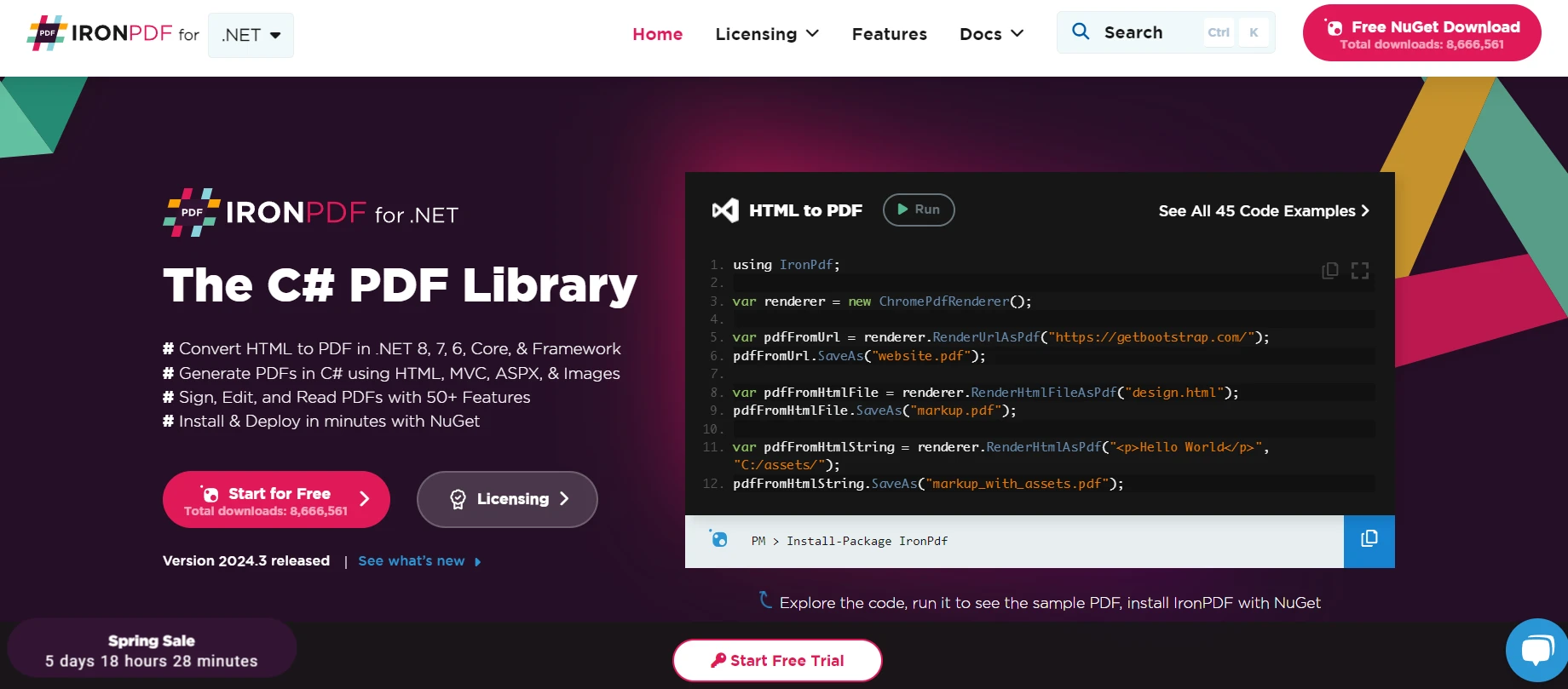Published April 4, 2024
C# Absolute Value (How It Works For Developers)
In C#, the absolute value refers to the distance of a number from zero, disregarding whether it is positive or negative. This tutorial aims to introduce the absolute value function in C# in a beginner-friendly manner, focusing on practical uses and coding examples. We'll also learn about the IronPDF library later in the article.
Introduction to Absolute Value in C#
In C#, the Math class provides a method named Abs, which calculates the absolute value of different numerical types such as int, double, float, long, decimal, etc. The absolute value of a number is its value without regard to its sign. The absolute values of both 8 and -8 are 8.
Syntax of Absolute Value in C#
The syntax for obtaining the absolute value of a number in C# involves using the Math.Abs method. This method is a part of the System namespace and is accessible through the Math class, which provides various mathematical functions. The Math.Abs method returns the value of the specified number, ensuring the positive values as the return value output, regardless of the sign of the input.
Here is a basic overview of the syntax for the Math.Abs method:
public static int Abs(int value);public static int Abs(int value);public static Integer Abs(Integer value)- public static int: This indicates that the Abs method is public (accessible from other classes), static (callable on the class rather than an instance of the class), and returns an integer value.
- Abs: The name of the method.
- (int value): The parameter list for the method, indicating it takes a single integer named value.
The Abs method returns the absolute value of the value parameter passed to it. It converts negative values to positive values while leaving positive values unchanged, effectively ignoring the sign bit.
Utilizing the Math.Abs Method
The Math.Abs method is a static method, meaning it can be called on the class itself rather than on an instance of the class. It is overloaded to work with various numerical types, thus providing flexibility depending on the specific requirements of your application. Here’s a basic example to demonstrate its usage:
using System;
class Program
{
static void Main()
{
int value = -10;
int result = Math.Abs(value);
Console.WriteLine("The absolute value of {0} is {1}", value, result);
}
}using System;
class Program
{
static void Main()
{
int value = -10;
int result = Math.Abs(value);
Console.WriteLine("The absolute value of {0} is {1}", value, result);
}
}Imports System
Friend Class Program
Shared Sub Main()
Dim value As Integer = -10
Dim result As Integer = Math.Abs(value)
Console.WriteLine("The absolute value of {0} is {1}", value, result)
End Sub
End ClassIn the example above, the Math.Abs method takes an integer value -10 and returns its absolute value, 10. When you run the program, it'll show the following output on the console:
The absolute value of -10 is 10The absolute value of -10 is 10'INSTANT VB TODO TASK: The following line uses invalid syntax:
'The absolute value @of -10 is 10Practical Examples of Math.Abs
Let’s dive deeper with more practical examples showcasing how the Math.Abs method can be applied in real-world scenarios.
Example 1: Handling Financial Data
When dealing with financial data, you might encounter situations where you need to calculate the absolute difference between two numbers, regardless of their order. The Math.Abs method can be quite handy in such cases.
int expense = -2000;
int income = 5000;
int netIncome = income + expense;
Console.WriteLine("Net Income: " + Math.Abs(netIncome));int expense = -2000;
int income = 5000;
int netIncome = income + expense;
Console.WriteLine("Net Income: " + Math.Abs(netIncome));Dim expense As Integer = -2000
Dim income As Integer = 5000
Dim netIncome As Integer = income + expense
Console.WriteLine("Net Income: " & Math.Abs(netIncome))This simple program calculates the net income and then uses Math.Abs to ensure the output is a positive number, which might be useful for certain types of financial reporting or analysis.
Example 2: Game Development
In game development, finding the distance between two points on a grid often requires absolute values to ensure positive results. Here’s how you could use Math.Abs in such a context:
int x1 = 4, y1 = 4; // Point A coordinates
int x2 = 1, y2 = 1; // Point B coordinates
int distance = Math.Abs(x1 - x2) + Math.Abs(y1 - y2);
Console.WriteLine("Distance between points: " + distance);int x1 = 4, y1 = 4; // Point A coordinates
int x2 = 1, y2 = 1; // Point B coordinates
int distance = Math.Abs(x1 - x2) + Math.Abs(y1 - y2);
Console.WriteLine("Distance between points: " + distance);Dim x1 As Integer = 4, y1 As Integer = 4 ' Point A coordinates
Dim x2 As Integer = 1, y2 As Integer = 1 ' Point B coordinates
Dim distance As Integer = Math.Abs(x1 - x2) + Math.Abs(y1 - y2)
Console.WriteLine("Distance between points: " & distance)This example calculates the Manhattan distance between two points, which is a common operation in grid-based games or applications.
Error Checking and Performance
While Math.Abs is straightforward to use, incorporating error checking is essential, especially when dealing with int.MinValue. Due to the way integers are represented in memory, the absolute value of int.MinValue cannot be represented as a positive int. In such cases, the method throws an OverflowException. Here's how you might handle this:
try
{
int value = int.MinValue;
int result = Math.Abs(value);
Console.WriteLine(result);
}
catch (OverflowException)
{
Console.WriteLine("Cannot compute the absolute value of int.MinValue due to overflow.");
}try
{
int value = int.MinValue;
int result = Math.Abs(value);
Console.WriteLine(result);
}
catch (OverflowException)
{
Console.WriteLine("Cannot compute the absolute value of int.MinValue due to overflow.");
}Try
Dim value As Integer = Integer.MinValue
Dim result As Integer = Math.Abs(value)
Console.WriteLine(result)
Catch e1 As OverflowException
Console.WriteLine("Cannot compute the absolute value of int.MinValue due to overflow.")
End TryRegarding performance, Math.Abs is highly optimized in the .NET framework. However, for critical sections of code where performance is paramount, manual inline comparisons may slightly outperform calling Math.Abs, especially in tight loops or performance-critical applications.
Overloads and Supported Types
Math.Abs supports several overloads for different numerical types. Here are examples for each supported type, showcasing the method's flexibility:
// For int
Console.WriteLine(Math.Abs(-10));
// For double
Console.WriteLine(Math.Abs(-10.5));
// For decimal
Console.WriteLine(Math.Abs(-10.5m));
// For long
Console.WriteLine(Math.Abs(-12345678910L));
// For float
Console.WriteLine(Math.Abs(-10.5f));// For int
Console.WriteLine(Math.Abs(-10));
// For double
Console.WriteLine(Math.Abs(-10.5));
// For decimal
Console.WriteLine(Math.Abs(-10.5m));
// For long
Console.WriteLine(Math.Abs(-12345678910L));
// For float
Console.WriteLine(Math.Abs(-10.5f));' For int
Console.WriteLine(Math.Abs(-10))
' For double
Console.WriteLine(Math.Abs(-10.5))
' For decimal
Console.WriteLine(Math.Abs(-10.5D))
' For long
Console.WriteLine(Math.Abs(-12345678910L))
' For float
Console.WriteLine(Math.Abs(-10.5F))Each overload is tailored to the specific numerical type, ensuring that your application can handle absolute value calculations across a wide range of scenarios.

Best Practices for Using Math.Abs and Absolute Values
When incorporating absolute values into your applications, there are several best practices:
- Error Checking: Always consider edge cases such as int.MinValue, where calling Math.Abs can result in an OverflowException.
- Performance Considerations: For performance-critical sections, test whether Math.Abs meets your performance needs or if a custom implementation could offer improvements.
- Understand Your Data: Choose the appropriate overload of Math.Abs based on the data type you're working with to avoid unexpected results or performance issues.
- Code Readability: While optimizing for performance, ensure your code remains readable and maintainable. Sometimes, the clarity of using Math.Abs directly outweighs minor performance gains from a custom implementation.
Introduction of IronPDF: A C# PDF Library

IronPDF is a .NET PDF library for C# developers, which allows the creation and manipulation of PDF documents directly within .NET applications. It simplifies working with PDF files by offering a wide range of features directly accessible through code.
IronPDF supports generating PDFs from HTML Strings, URLs, HTML files, images, and many more. Its easy integration into .NET projects allows developers to quickly add PDF functionality without deep diving into complex PDF standards.
Code Example
The following example shows the main functionality of IronPDF:
using IronPdf;
class Program
{
static string SampleHtmlString = "<h1 style='position:absolute; top:10px; left:10px;'>Hello World!</h1><p style='position:absolute; top:50px; left:10px;'>This is IronPdf.</p>";
static void Main(string[] args)
{
License.LicenseKey = "ENTER-YOUR-LICENSE-KEY-HERE";
HtmlToPdfExample(SampleHtmlString);
}
static void HtmlToPdfExample(string htmlString)
{
ChromePdfRenderer renderer = new ChromePdfRenderer();
PdfDocument newPdf = renderer.RenderHtmlAsPdf(htmlString);
newPdf.SaveAs("pdf_from_html.pdf");
}
}using IronPdf;
class Program
{
static string SampleHtmlString = "<h1 style='position:absolute; top:10px; left:10px;'>Hello World!</h1><p style='position:absolute; top:50px; left:10px;'>This is IronPdf.</p>";
static void Main(string[] args)
{
License.LicenseKey = "ENTER-YOUR-LICENSE-KEY-HERE";
HtmlToPdfExample(SampleHtmlString);
}
static void HtmlToPdfExample(string htmlString)
{
ChromePdfRenderer renderer = new ChromePdfRenderer();
PdfDocument newPdf = renderer.RenderHtmlAsPdf(htmlString);
newPdf.SaveAs("pdf_from_html.pdf");
}
}Imports IronPdf
Friend Class Program
Private Shared SampleHtmlString As String = "<h1 style='position:absolute; top:10px; left:10px;'>Hello World!</h1><p style='position:absolute; top:50px; left:10px;'>This is IronPdf.</p>"
Shared Sub Main(ByVal args() As String)
License.LicenseKey = "ENTER-YOUR-LICENSE-KEY-HERE"
HtmlToPdfExample(SampleHtmlString)
End Sub
Private Shared Sub HtmlToPdfExample(ByVal htmlString As String)
Dim renderer As New ChromePdfRenderer()
Dim newPdf As PdfDocument = renderer.RenderHtmlAsPdf(htmlString)
newPdf.SaveAs("pdf_from_html.pdf")
End Sub
End ClassThis PDF file generated by IronPDF:

Conclusion

In this tutorial, we explored the Math.Abs method in C#, which provides a robust and flexible way to calculate the absolute values of numbers across various data types. From handling financial calculations to game development scenarios, the Math.Abs method is an essential tool in the C# developer's toolkit.
Understanding how to use this method effectively can simplify your code and make it more resilient to negative input values. If you want to use IronPDF in your projects, you can try their free trial. And license starts from $749.











